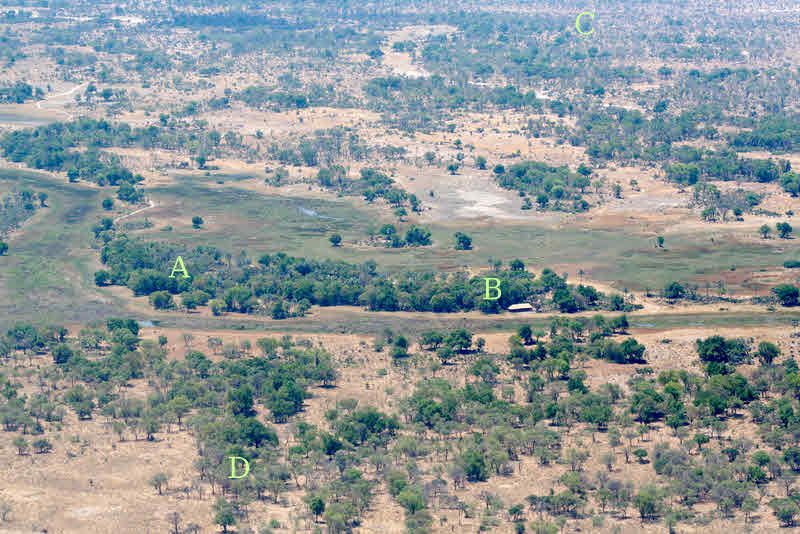
We flew in a normal commercial jet to Maun, and from there in a variety of smaller planes out to our wonderful stay in the delta. I was treated to the co-pilot's seat in a small Cessna, so was in 7th heaven... and the pilot and my fellow passengers were willing to have the window open for the sake of good photographs, so here is one of the camp, taken looking to the north.

Text and photos on this page © TK Boyd 11/08
Key to photo....
In the main camp, people looked out over the riverbed towards the west, to the left of "A" in the photo. In Lediba, we looked out to the south, over the riverbed "this side" of the lodge in this picture. (See the next photo for more details.) The airstrip serving the camp was 7km to the north, i.e. in the direction of "C".
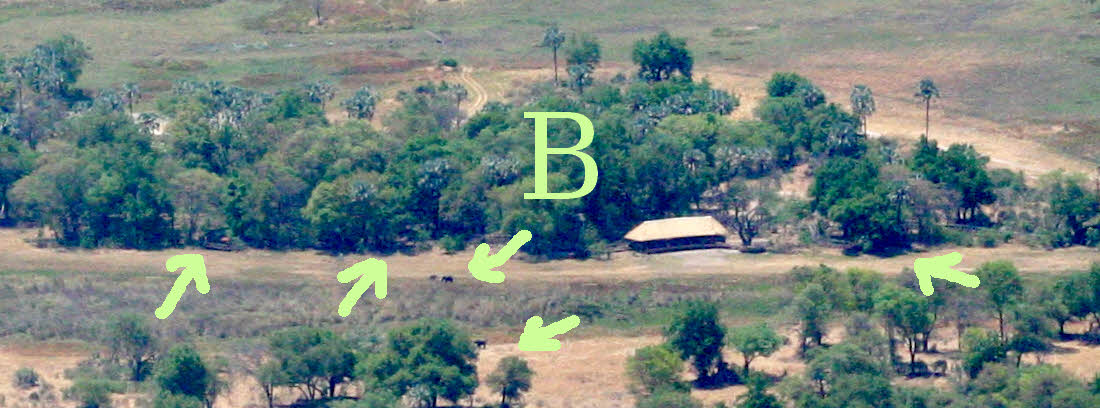
You need to study this detail from the photo above to take in what is shown in the larger photo. The obvious building is the communal area for meals, relaxation, etc... and it is HUGE. (And recently re-built, following a tragic fire.)
See the elephants in the river bed? Now do you understand when I say the lodge is huge? (Elephants marked by downward pointing arrows.)
At the right of the lodge is a circular deck quite capable of holding 20 people in a ring of chairs around a campfire.
The upward pointing arrows mark the big tents on platforms where we lived, two to a tent. (Mine marked by the second arrow from the left.) Rather luxurious tents, with plumbing, and a second shower outside overlooking the riverbed. (We were asked not to tempt the local wildlife by using the outside showers at night.)
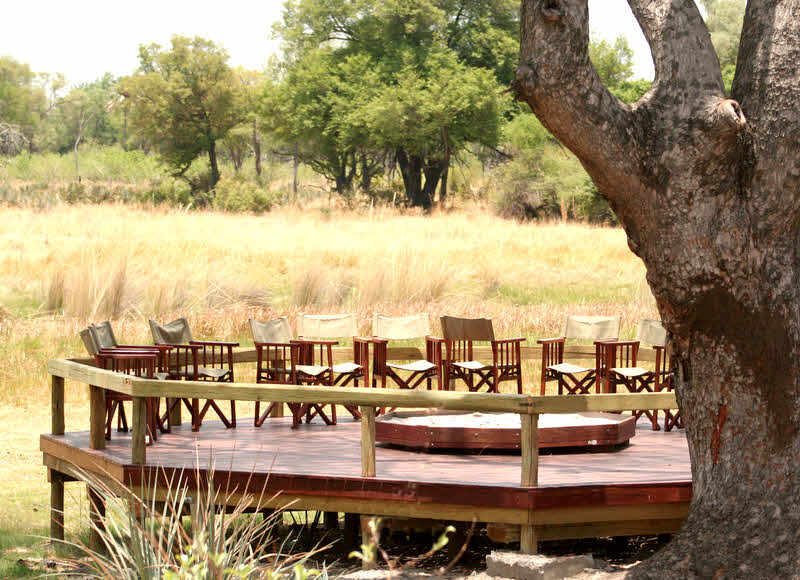
This is the circular deck mentioned above, this time viewed looking towards where the plane was when I took the aerial view.
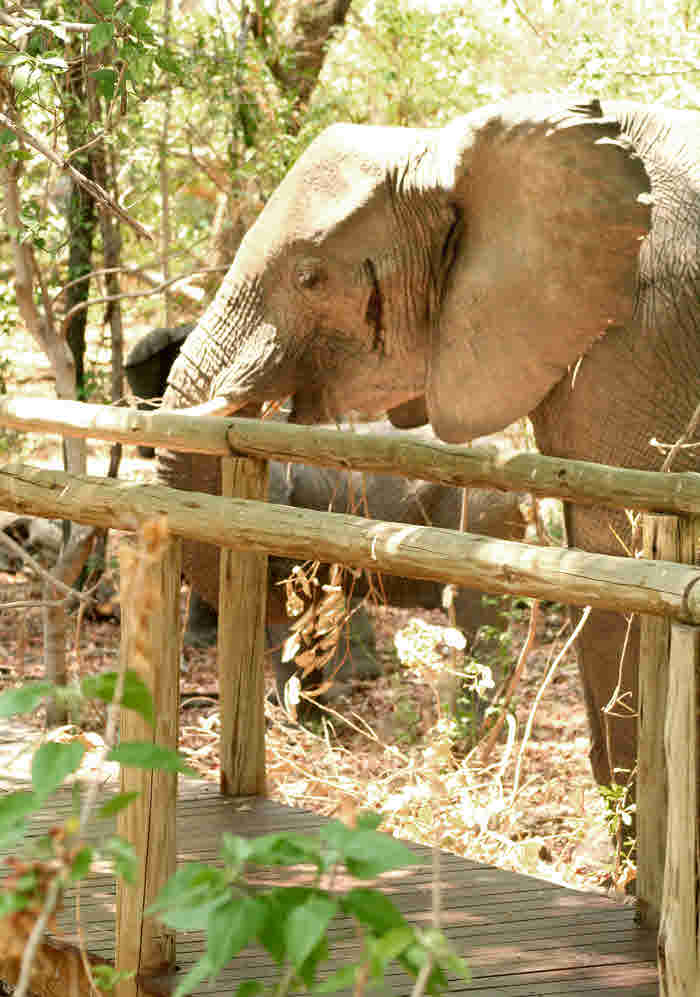
To the right you see a photo depicting two things. Walkways like the one you see connected everything we needed to access... the communal areas, our tents, etc. Not only were they convenient, but they were there to keep us safe from the remote danger of snakes, etc. And you can see that the elephants were not always out in the river bed. When they were this close, we just had to wait until they wandered off. They aren't aggressive, but they don't like to be crowded, especially if they have young with them. On the other hand, we were encouraged to be assertive with the baboons and tell them that we were going to use the walkway and that the 'boons would just have to move.
After dark, we were asked not to go to our tents alone; we were escorted by someone with local knowledge.
Were we in any danger? Of course not... if we kept to the rules. We weren't in Kansas.
While the elephants here at Chitabe could be inconvenient at times, wait 'til you hear of the impact of the elephants at Mfuwe!
.
On our first game drive, we had an exceptional experience which I will relate in a moment, but first a word about the daily routine.....
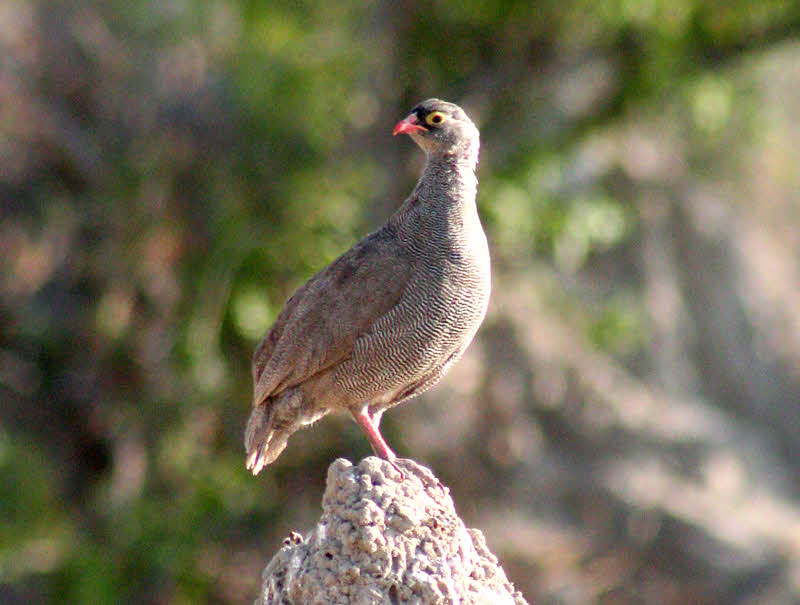
We rose at 5 (Chitabe) or a little later (Mfuwe). Seemed harsh at the time, but well worth it. Sunrise and sunset were very abrupt. At 5 the sky was lightening, by 5:45 the sun was up. (Bird in photo is a red-billed francolin, Francolins adspersus... an abundant bird. Very useful for locating predators, as they squwak and alarm call. Maybe the Latin species name arose because the namer thought this bird is often casting aspersions? They are certainly noisy.)
A good buffet breakfast (Marmite included) was provided, after which we went out in the Land Rovers while the day was still cool, the animals still active. The best light for photography was early and late in the day, too.
By late morning, the heat was rising, and the wildlife was shutting down for the middle of the day. We would then have our main meal, either on the trail, or back at camp. Both Chitabe and Mfuwe did a good job of springing surprises to keep things fun. Always we were treated to first class arrangements... linen, good crockery, etc.
After lunch, elephants permitting (more anon), we had an excellent lecture from JB. After that it was siesta time... and usually too hot to consider anything else, except maybe relaxing in the pool. The air wasn't particularly humid, but on one or two days I would guess the temperature topped 100 ° F / 38 ° C. Not only were we not fit to be moving in that heat, but the animals were too sensible to do so. Hence resting made sense. It was easy to get dehydrated, espeically as we were rarely particularly sweaty. Sweat disappeared into the air before it became an issue.
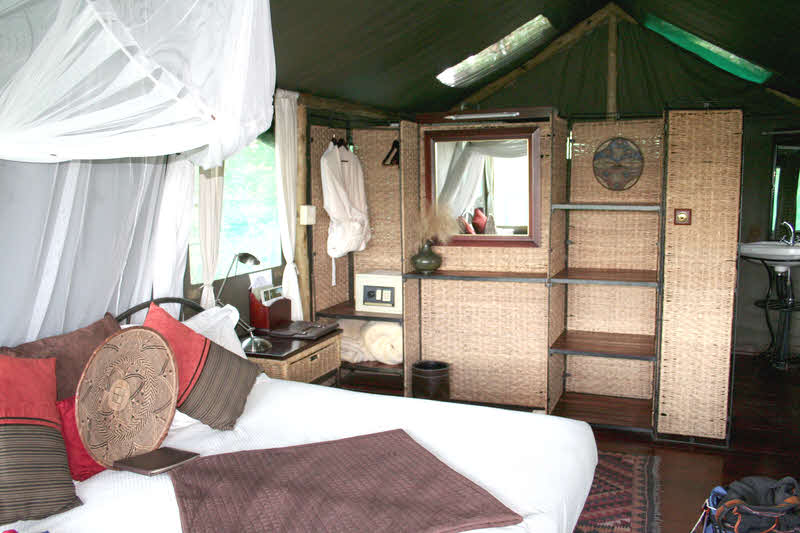
Our comfortable Chitabe Ladiba "tent" bedroom.
In some ways, 3:30pm was the start of the day. The worst of the day's maximum heat was about to pass. It was at that time that I usually had my major wash of the day, put on fresh clothes, etc. At 4pm there was a proper British tea, to prepare us for the start of the afternoon/ evening game drive. (Recall that both Botswana and Zambia were British colonies.)
We stayed in the same sub-groups, with the same drivers, for all of our time at each camp. This worked out very well, as the drivers knew what each of us had seen.
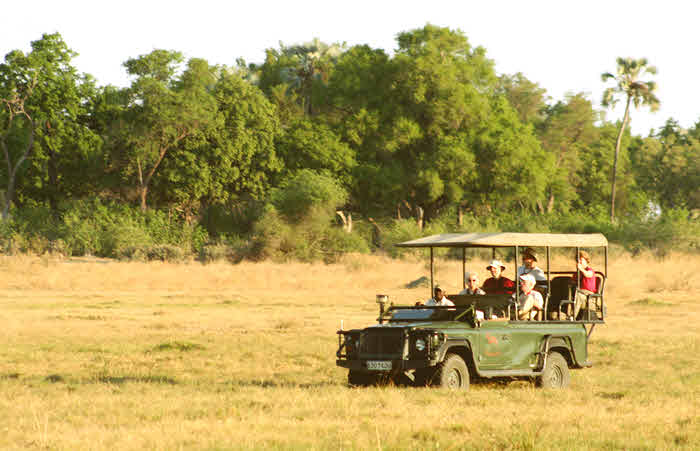
The afternoon/ evening drive was similar to the morning drive... until the end of the day, which came suddenly. Our drivers were expert at being in the right place, at the right time, to join up with the other vehicles in a beautiful spot for "Sundowners"... aka "cocktail "hour"", which lasted a bit less than an hour. We would arrive in daylight, set up, have a good social time watching the amazing African skies.... the eastern sky being as interesting as the western sky as the sun set. While we had almost no rain, we were there right at the end of the dry season, and saw some magnificent cloud formations piling up. And then it was fully night. And we would set off back towards camp, with our driver using a powerful hand lamp to look for nocturnal wildlife, spotted primarily by eye-shine. We had very good luck with our night drives, especially in Botswana.
One of the delights of the Okavango experience is that you are not restricted to the "roads". (Generous term.) If your driver sees fit, you can set off cross country. Also, you will be the only people within the concession you are visiting.
Back at camp, a fine dinner would await, after which beds called imperiously.
Both camps featured central communal areas augmented by strings of "rooms" trailing away from the communal areas. At night, we were asked not to go to our rooms without a guide to escourt us, to keep us safe.
At Chitabe (and Chitabe Labida, Chitabe's "sister" camp, where half of us stayed) the rooms were spacious, luxurious tents on platforms. At Mfuwe we were in "proper" buildings, one to each room-mate pair.
So! That sets the scene, I hope. On to the animals.....
If you go to the right places, you are pretty well guaranteed to see lions, etc.
Wild dogs, on the other hand, for various reasons, are never guaranteed. For a start they are a very rare beast, perhaps only 4,000 remain in the wild. They occur over a limited range. (There's more in the Wikipedia article.) But that's just the start of your challenge if you want to see one. They travel in packs... travel being the operative word. Although a pack's range will not be exclusive... several packs may "work" certain areas... a given pack may turn up anywhere within about 500 square miles. And if you see them "here" today", expect them to be "there" tomorrow.
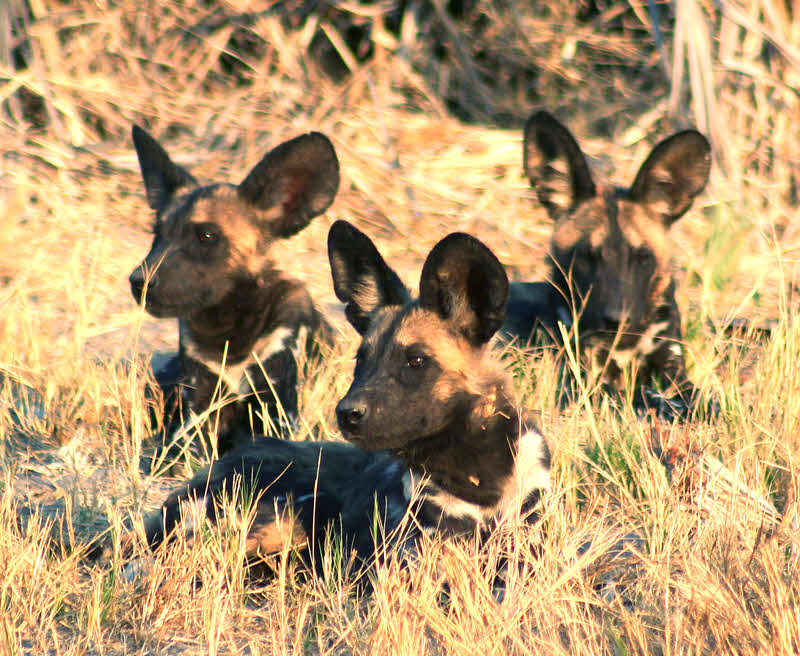
We were exceedingly lucky. We arrived at Chitabe at 2pm on the 27th, and set off for our first game drive at 4:15. Wild dogs had been seen in the area, and might still be around. We drove, seeing lots of wonderful things along the way, about 6 miles north of camp.... and, at 5:30, found the dogs! Just seeing a pack of the dogs was an incedibly lucky start to our trip... but there was more to come.
It was late afternoon, and the pack was still finishing its afternoon siesta.
The full story of our amazing wild dog encounter is on it's own page.
Puppies, African hunting dog (Lycaon pictus)
..
(I hope you've visited the page about the wild dogs? If so, moving on....)
The Okavango and our guides could be forgiven for thinking at this point that we'd had this day's money's worth, but there was still the night drive back to camp to come.
We had good sightings of a number of interesting animals...
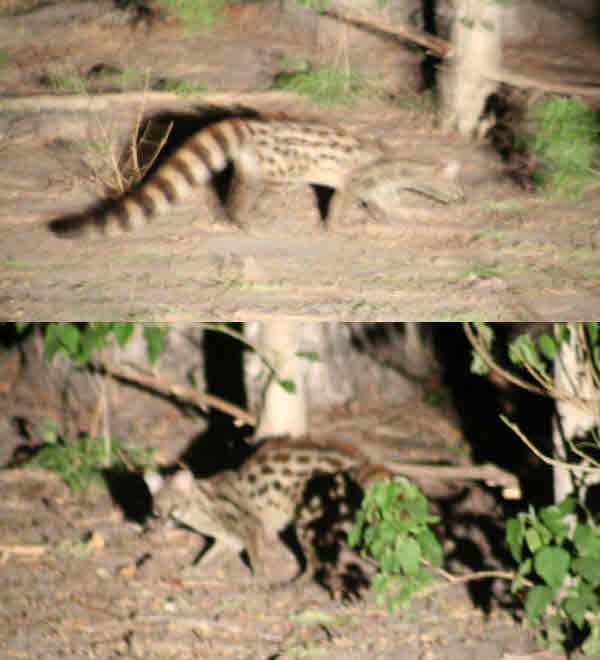
The genet is about 18 inches long, not counting the spendid ringed tail. A relative of the mongoose, this is a pretty, cat-like creature. I'm sorry not to have better photos. We saw them quite regularly on night drives.
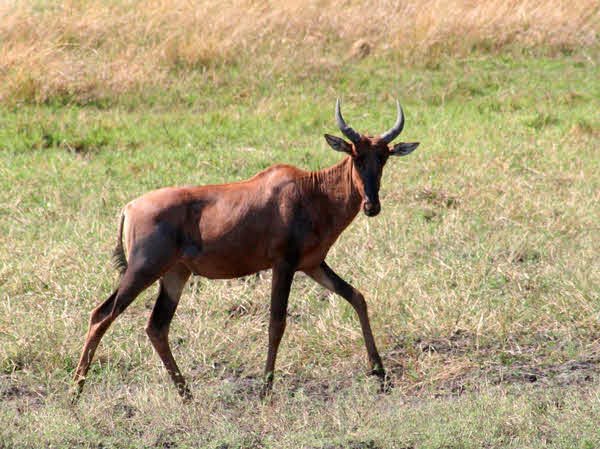
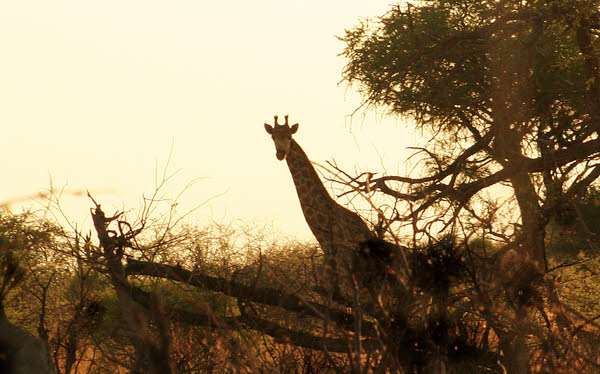
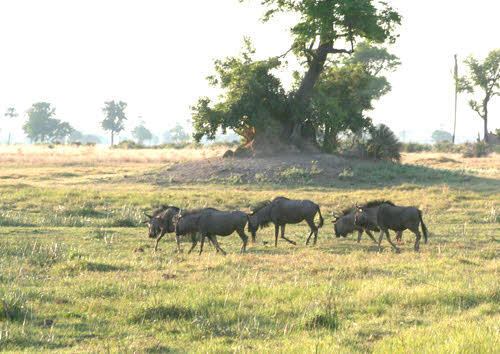
Tsessebe Giraffe Wildebeest
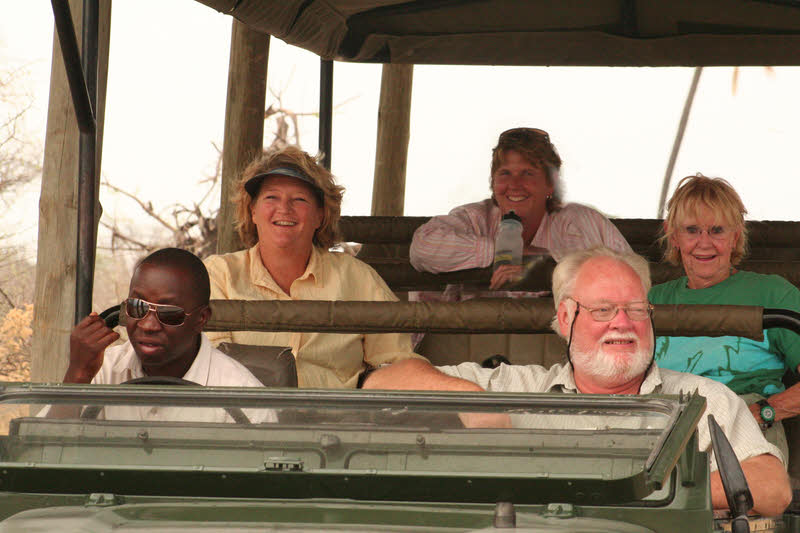
Although we were a party of 23 in total, during our days, we split into smaller groups. Thus, by the end of the day, different groups had seen different delights. The drivers were in communication with one another by radio, so if something special was found, and others were close enough, they could be summoned to share, but usually we were on our own in more intimate groups. I was very fortunate in the company I ended up with.
Each group kept the same driver/ guide. JB and Carol rotated between the groups, so everyone got "fair shares".
Our guide was "OT"... a skillful driver, and knowledgable guide. He knew how to find the animals, and he had a wealth of stories and facts for us.
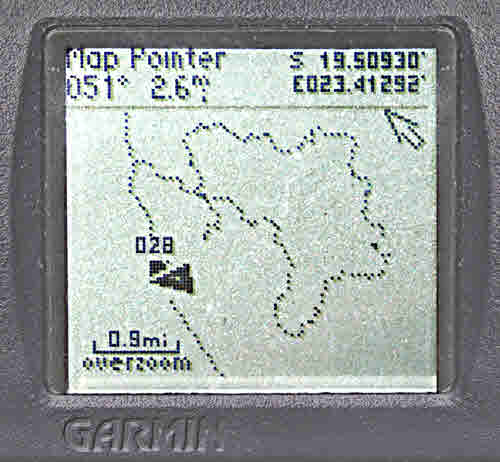
The GPS track of one of our morning drives, shown to the right, will give you an idea of how hard only half of OT's job was! Not only did he have to keep the Land Rover going over deeply rutted tracks, often through very soft sand, but he had to give us a ride as smooth as possible, and avoid getting us twacked in the face by branches... many of which were equiped with formidable thorns.
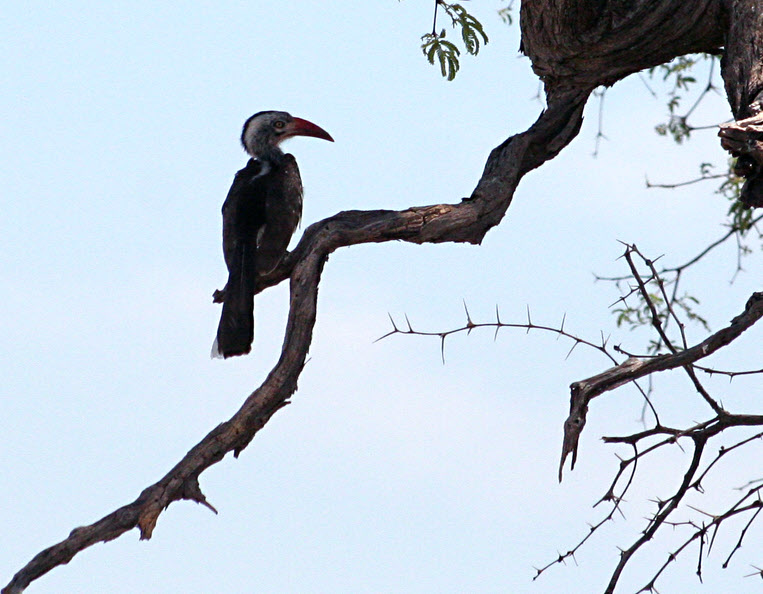
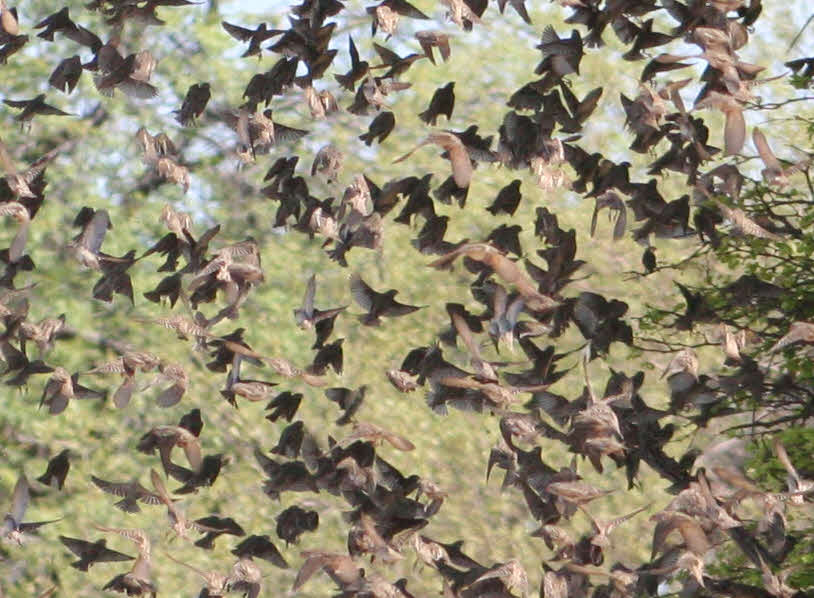
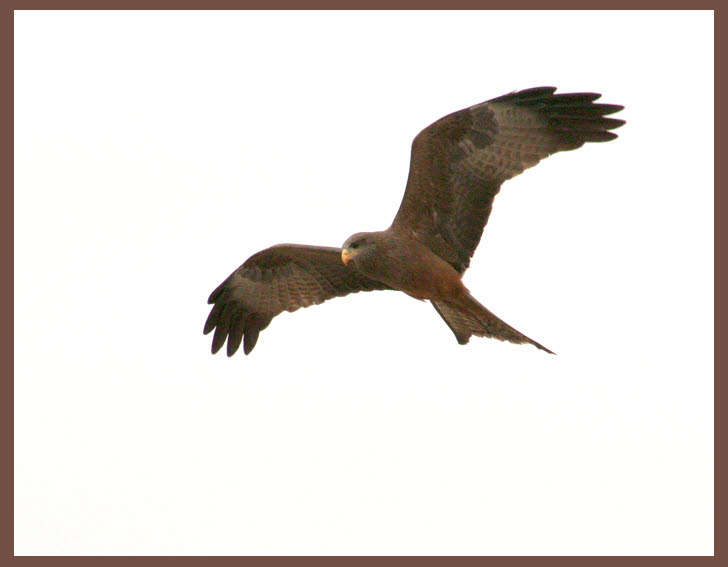
Hornbill Quelea Yellow -billed Kite
The sparrow-like quelea may be the most common bird on the planet. If a flock descends on a farmer's crop, he can be ruined in under an hour. Impressive to see.... flocks can look like a plume of smoke. Devastating to live with; not unlike locusts.
On the afternoon drive of our first full day (28 October), we were looking for whatever was there, but in particular for leopards and cheetahs. OT had schooled us in where to look, and in which to expect in a given habitat.
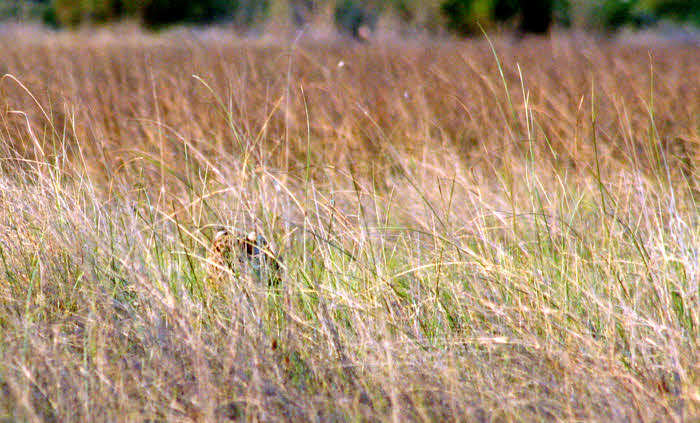
Jennifer had particularly fine eyes, being the first to spot several of our big finds, and at just after 6pm, as the light was turning early sunset yellow, she spotted the head you see in the photo on the left. It should have been a cheetah, from where we found it. The behind- the- ears markins were not visible to us at first.
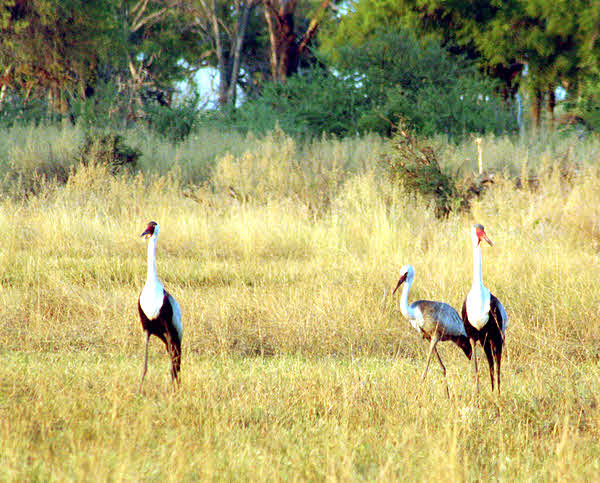
Soon, however, we realised we had a leopard. And it had dinner... the birds on the right here... on it's mind. But the wattled cranes were strategically placed in an open area, and the leopard was unlikely to be able to get them.
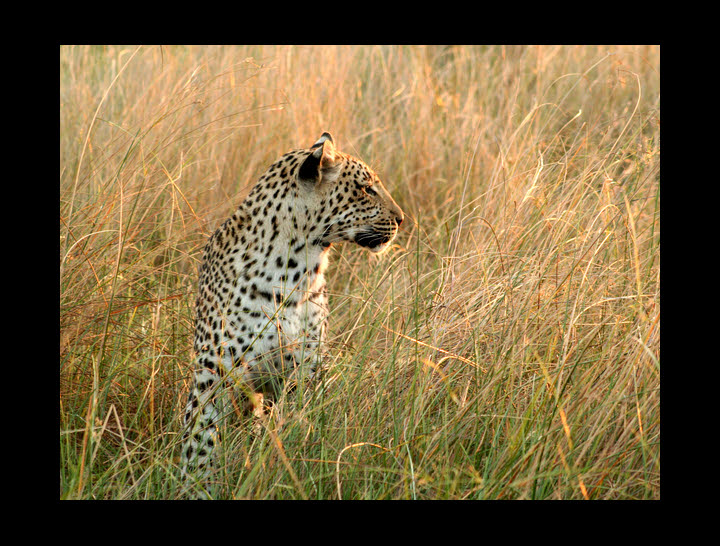
You can see this in higher resolution in a new tab.
We followed the leopard for a time. OT pointed something interesting out: when the leopard passed some francolin, they set up the usual racket. But then the leopard curled its tail upward, and the francolin stopped. OT explained that the leopard had "told" the francolin it wasn't hunting. He said he'd seen this many times.
A little while later, we passed a solitary hyena. We'd seen one briefly... my first... during the first night drive, as well. These are important elements in the grassland food web... they eat, among other things, bones. Hence their feces are often white. I must confess that I fail to find them especially loveable, but I was pleased to see one. Little did I know of the encounter which was to come just before we left Chitabe.
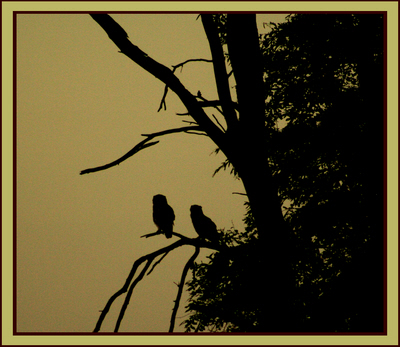
We had the usual sundowners, and headed back to camp. These owls (to the left) were drinking? catching frogs? at a waterhole.
Only about ten days before I left on this marvelous trip, the BBC had a week long special program: An hour every evening with live material from the Masai Maura, intersperced with "things they filmed earler". The programme title "Big Cat Diary" will tell you what the programs focused on. Could anything better get me excited about my trip to come? You can still seem material from the show on the BBC website, although you may not be able to access some high bandwith material from the States. At one point during that programme, we saw a single adult lioness in trouble... she'd been found by several hyenas. Fortunately her sisters turned up... which was more than the hyenas could handle... before enough hyenas to kill her had gathered.
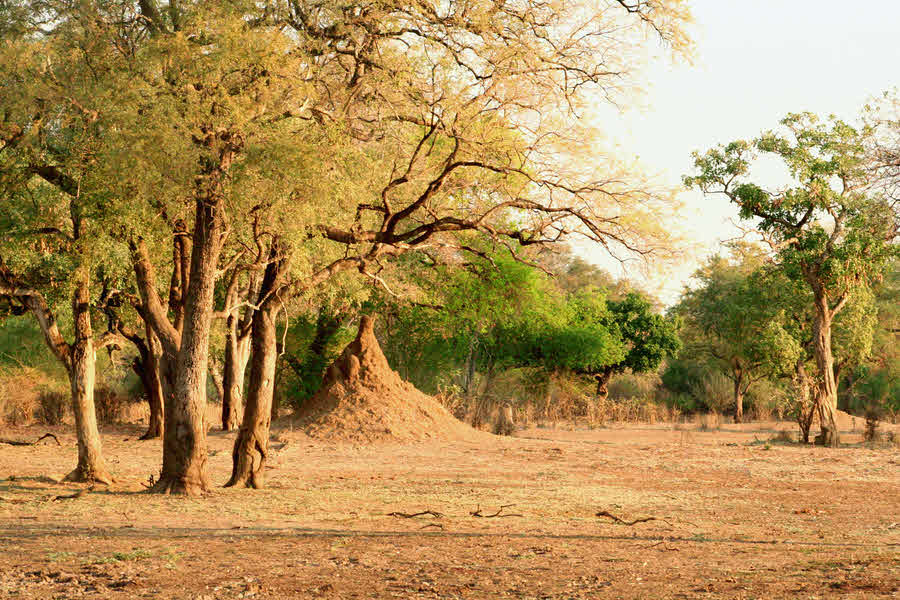
OT was careful not to tell us more than we wanted to know. In particular, he kept a tight rein on his enthusiasm for termites. However, happily, everyone in our group wante to be told things, and OT was ready, once encouraged, to oblige. A queen can live for 20 years. Can produce young for that whole period after a single mating. It turned out that OT's father had been a helper during the filming of the 1980s "Castle of Clay" documentary, which used revolutionary (for its time) filming techniques.
The height of the mound tells you how deep the water table is beneath the mound.
Like leafcutter ants, the mound termites "farm" fungi. It is the heat from these "farms" which drive the "air conditioning" system of the mound.
An active mound investigated in Zimbabwe was found to have existed from about 1100AD... this date determined by the carbon dating of human remains mixed up with the mound. (Hmmm... as I write this, it seems to me that the "proof" was that the human remains were under the mound. But that doesn't make sense: The remains could be dated, but how do we know when the mound was started on top of the human remains? 900 years ago, or last week. So- I can't explain the logic, but can only report the elements of the arguement, as I remember them. OT impressed me as someone sensible who knew what he was talking about, even if I can't recall properly what he told us.)
The weight of all the termites, including the ones that don't make mounds, may be as great as the weight of all the other animals in the habitat put together.

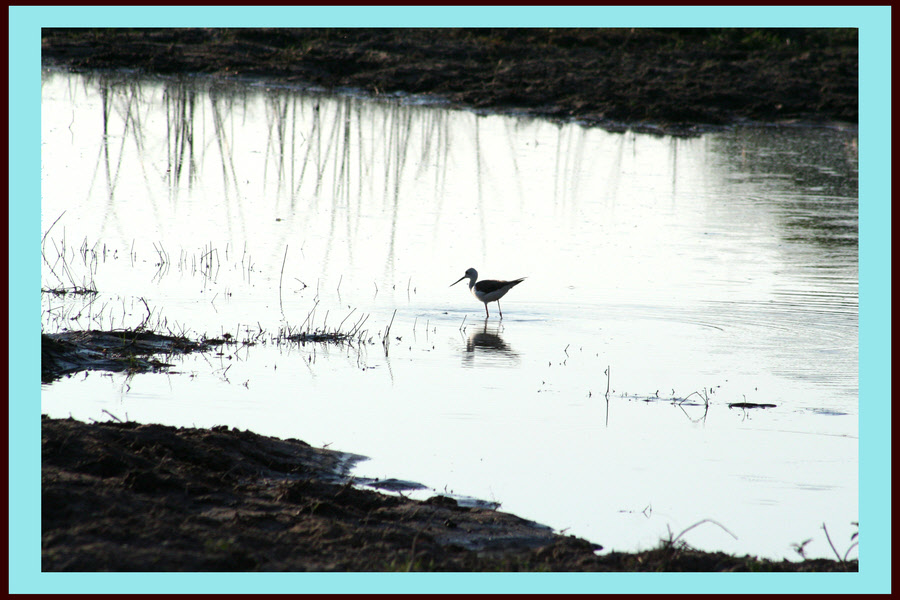
Standing by waterways was not encouraged. This bad boy was about 8 feet long.
The next morning (29th October) we came upon two adult ostriches with many, many young. 30? (I have photos, which I will try to incorporate.)
It turns out that in ostrich society, a dominant pair's nest will be parasitised by other ostriches... subordinate females lay eggs in the dominants' nest, and then disapear, have nothing more to do with raising the young! Not only that, but as the dominant pair travel around with the young after they've hatched, if the calvalcade encounters a weaker pair, also with young, the young from the weaker pair's creche will transfer their allegience to the dominant pair, and their creche grows! Quite strange, in terms of the usual "I'm not raising individuals with your genes" rules. Perhaps the dominant pairs' own young survice better in a "school" of young, from which predators take prey at random?

Shortly after seeing the ostriches, we encountered these elephants. It was a moment or two before they deigned to get all of their group on one side the track so that they were comfortable to permit us to pass.

We were now quite a ways from camp, and moving into drier and drier terrain. It was along here that we encountered the delicate little (30 lbs) steenbok, which is generally solitary and more like a large hare than a small antelope. OT, and Dorst & Dandelot's "Larger Mammals of Africa" agree that these animals rarely if ever drink water, surviving on the moisture in what they eat. (Most of my weight and size figures come from the book cited.)
At last, we crested the ridge, left the dry country, and came down onto the floodplain along the river that is the northern boundary of the Chitabe concession. And what a feast of wild-life we found there!
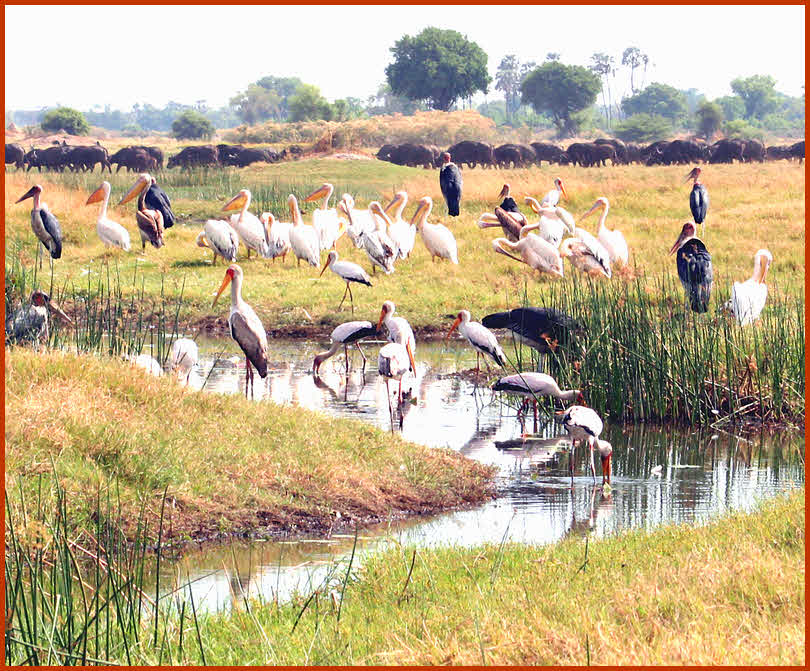
Birds were very abundant. These pelicans and storks were "shooting fish in a barrel", the fish having been concentrated by the months of shrinking watercourses.
And you see the buffalo in the backgound? Very pretty they were. What you can't see from this picture is that they were part of a migrating skein of hundreds... and that skein had got itself between us an where we had come from. The photo is taken looking south. Quite close to the north of us is the river. Not the sort of stream we often splashed though with our snorkel equipped Land Rover. A river. With hippos and crocs. We weren't in "danger"... but things were a touch awkward.
Here's the situation a few minutes later.

But eventually a gap appeared in the migrating buffalo, and we were able to continue our game drive.
A little while later we saw vultures wheeling down out of the sky. OT told us that it was probably a fresh cheetah kill... a leopard would have taken the kill up a tree where the kill could not be stolen. Sadly, we didn't see the cheetah.... guess I just have to go back to Africa again. Of course, if I'd signed up more quickly for the Namibia trip, I could have stayed at a cheetah rehabilitation/ conservation establishment. Oh well.
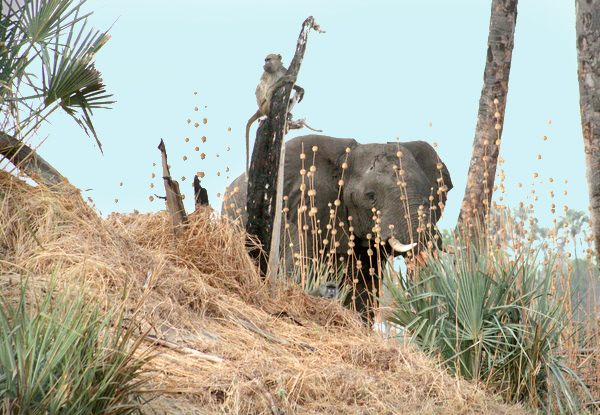
For our last afternoon/ evening drive, we set off to the south of camp for the first time. this elephant and baboon are seen in a stand of the very decorative wild dagga... a plant used to help asthma sufferers... and smoked for marijuana-like results.
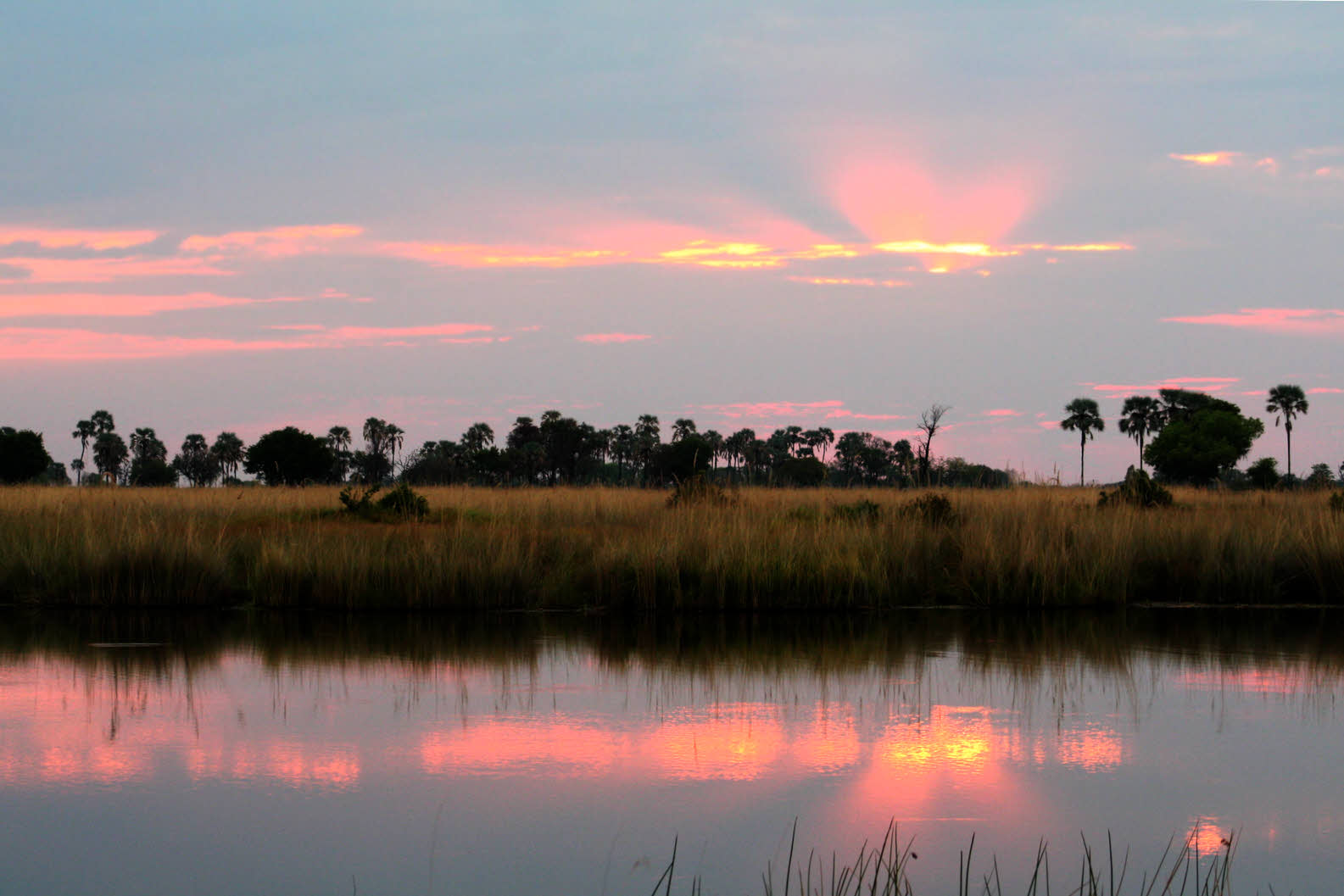
Our final Chitabe sundowner was on a bend in the river. Usually, we headed away from camp in the afternoon, had "sundownwers", and then, in the dark, headed back towards camp. So, when this evening we continued south after sundowners, I was mildly puzzled... but the reason for the deviation became clear. Up ahead appeared a large camp fire, in the middle of a 100 yard circle of kerosine lanterns. All of this in the midst of one of the big open areas which exist dotted about the landscape.
OT pulled up to tell us a story. No sooner than he'd started than Jennifer said "What's that?" Just ahead of us, whe'd spotted a leopard trying to have a quiet drink. Not just a leopard, but a leopard and at least one cub. When we went closer to investigate, we had one nice view of mother and cub. A moment later, closer, but in vegetation, we saw that there was not just one cub, but two, but all three vanished. Although it would require an unusual... but not unheard of... family group, there might even have been four leopards there... mother, a yearling, and two younger cubs.
Then, back where the leopards had tried to drink, we found a hyperventilating jackal. It had been seeing the leopards off when we arrived. It's mate appeared a moment later. Our quess was that they had puppies in a den somewhere nearby. They wouldn't have challenged leopards without a good reason.
Then OT went back to his story. As a youth, he and his friends had dispatched a nuisance crocodile... about as long in feet as they were old in years... by tying a rope around a goat skin wrapped around a sausage tree fruit. When the croc bit the bait, it had trouble pulling its teeth out of the "sausage", and the boys were able to pull the croc clear of the river and dispatch it with sticks and rocks. (Does this qualify as a "Dangerous Adventure for Boys"?)
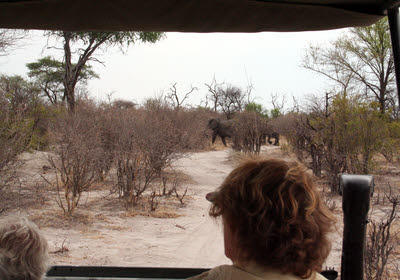
Soon were were on our way again... until we met up with some elephants. This was a group which was more excitable than most we had encountered. OT thought one of them with large tusks might have been hunted in the past. We just had to wait a bit until they were clear of the road.
Not long after that, we arrived at a water hole by the end of the aristrip where our plane would be collecting us. You can see airstip and water hole in the aerial ("satellite") view at maps.google.com.
And, although you can't see them via Google, there were hyenas in and around the water hole. We were a little early for our pick-up, so stopped to take pictures, etc. Two of the bigger hyenas were sitting in the water... to cool down seemed the likely explanation. Three or four younger hyenas were mooching about at the edges of the water.
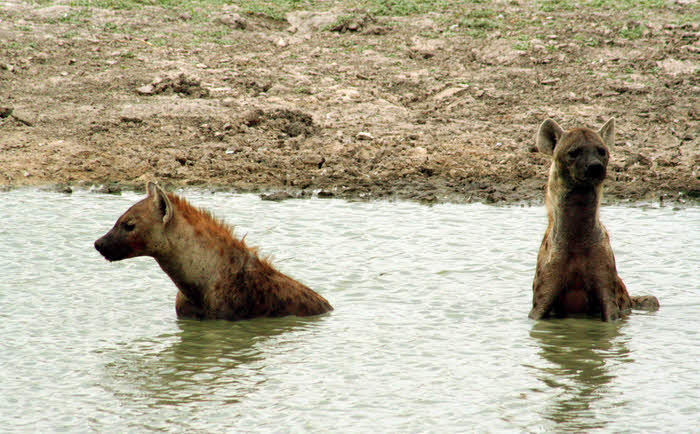
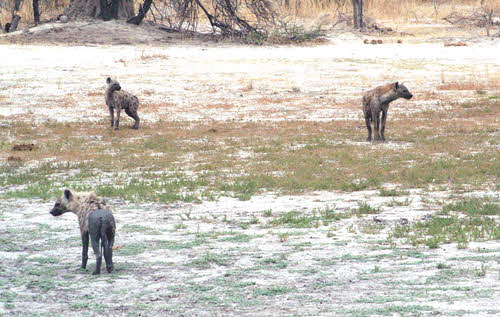
(The strange rump of the left hand hyena in the right hand photo is due simply to some mud.)
We were just about ready to move on, when SOMETHING HAPPENED.....
v v v -S-C-R-O-L-L - - - D-O-W-N- v v v
v v v
v v v
v v v -S-C-R-O-L-L - - - D-O-W-N- v v v
v v v
v v v
v v v -S-C-R-O-L-L - - - D-O-W-N- v v v
v v v
v v v
v v v -S-C-R-O-L-L - - - D-O-W-N- v v v
v v v
v v v
Like some monstrous apparation from they abyss, the not very nice, half eaten carcass of an impala was dragged out of the depths of the water hole by the dominant female hyena. She hadn't merely been cooling off. She'd taken her food into the water to hide the sight and smell of it from competition.
For some reason, despite our presence, she eventually concluded that it was dinner time, and took her meal onto dry land. The green water pouring from it is not an artifact of the photography... it really was that color.
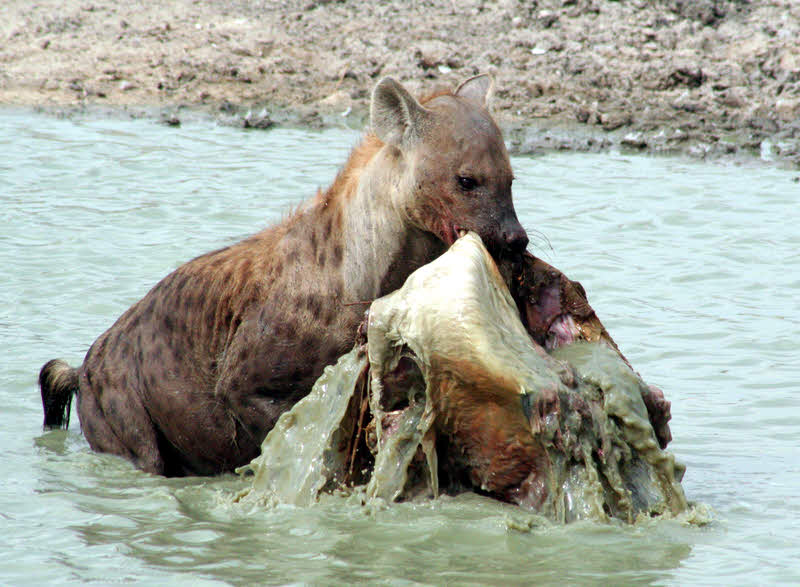
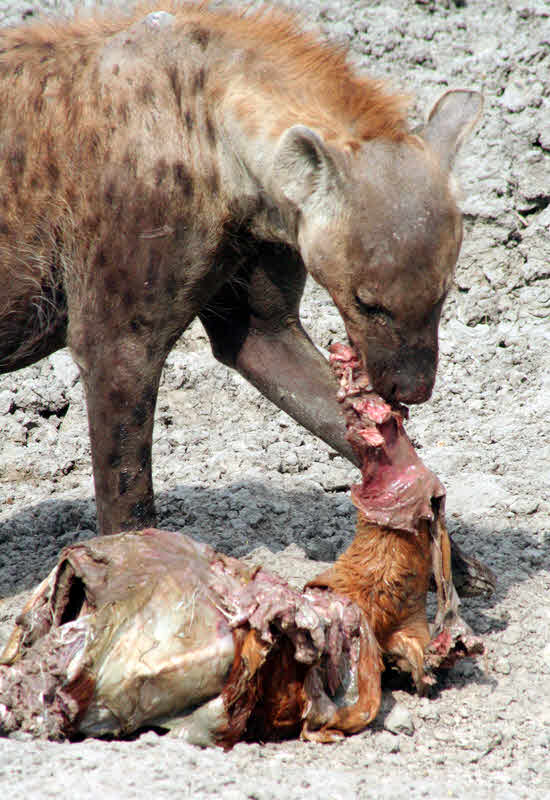
I fear I will not be inviting Ms Hyena to tea.
Let's end on a less repulsive note! Here is the gorgeous, frequently seen lilac brested roller. Some will tell you that it is the national bird of Botswana, showing, as it does, the country's national colors (blue, black, white). Others say that the national bird has not been decided, and in any case the lilac breasted roller is disqualified by having too many extraneous colors! Whatever. It is still a gorgeous bird, like the carmine bee-eater which we also saw quite often.
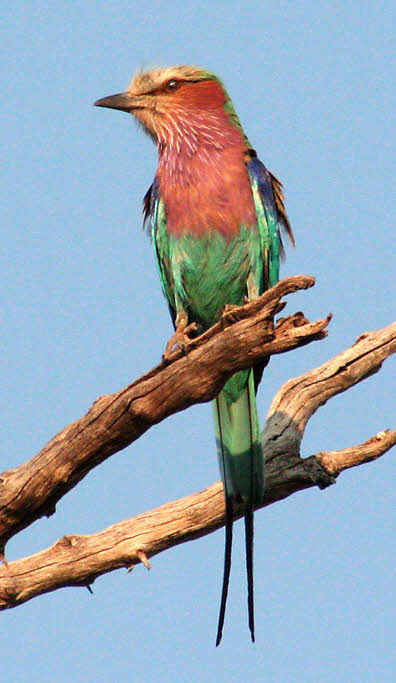
© TK Boyd 11/08. Click here to contact him.